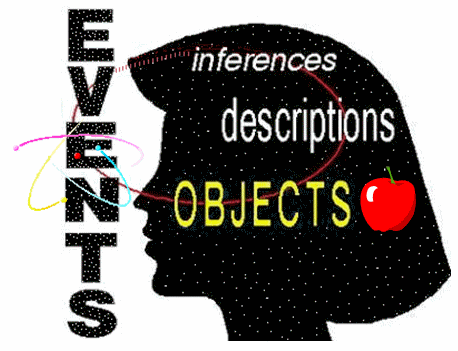
Structural Differential
Developed 1996 by Steven LewisThe Structural Differential by Steven Lewis is an alternative form of Korzybski's Structural Differential. Both serve as visual tools to train us to differentiate between the orders of abstractions ... to become conscious of abstracting.
The EVENT level represents the raw data from which we abstract. This level is the principal focus of study of the sciences of physics, chemistry and biology. The event level, or "scientific object," includes electrons, atoms, molecules, electromagnetic radiation, cellular organelles, cells .... The term "EVENT" and the evaluator in the diagram are shaded the same to indicate that we, too, are composed of electrons, atoms, molecules, cells .... We are not merely observers of the world, we are part of the world. The EVENT level also includes details that we do not abstract, or cannot abstract, including events on the dark side of the moon and events of the past. The unlimited characteristics and dynamics of the event level are indicated by the numerous dots within the diagram.
The OBJECT level could also be labelled "first order abstractions" or "lower order abstractions." In the old language we called the object level the sensory level. This is the level of what we see, hear, touch, taste .... Note that the term "OBJECT" is in color to reflect that our nervous system 'colors' what has been abstracted. For example, we see electromagnetic radiation of different frequencies as different colors. We hear different frequencies of mechanical vibrations as sounds of different pitch. Sounds, colors, solid objects serve as the results of our nervous system translating the raw data of the event level into the sense language of the nervous system.
The DESCRIPTION level corresponds to statements we make about what we abstract in terms that involve relatively little judgement, opinion, hypothesizing and are, therefore, closer to the abstracted facts. If you arrived home one day to find your television missing you could say "My TV is missing."
If you concluded that your TV had been stolen, then you move to a higher order of abstraction, the INFERENTIAL level. This level involves connecting the data points to produce a smooth curve or theory. Here we go beyond the mere facts to try to draw some conclusions. We take the data we abstract and fill in the gaps.
The red circle that connects these different orders of abstraction with the EVENT level reveals that what we abstract from the EVENT level, including our theories about the nature and origins of the world, are projected back onto the EVENT level. This is what Korzybski referred to as the circularity of human knowledge. Our theories about the structure of the atom, or who killed President Kennedy, are read back onto the event level.
If we are conscious of abstracting, however, we will not confuse a particular theory with the actual events themselves. We will be conscious that we may abstract the traffic light as red, but Daltonists (red-green color blindness) won't. We may evaluate lunch as great, others may not. We may abstract Oswald as Kennedy's lone killer, others may abstract a conspiracy. If we are conscious of abstracting, we include ourselves as an inevitable part of our evaluations, helping to make us more curious about and tolerant of the alternative abstractions of others. This consciousness of abstracting is implied in part by the dashed red line that connects our inferences with the EVENT level.
In the Structural Differential by Steven Lewis, EVENT is printed more prominently than OBJECT, OBJECT receives greater emphasis than "description," "description" is emphasized over inference. This relative emphasis reflects what Korzybski called the natural order of evaluation, which is characteristic of modern science-mathematical behavior. The natural order is facts first, theories second in importance. Theories in science are held to the test of empirical verification, and if they do not pass the test they will be discarded.
Charles Darwin, for example, is probably the most respected biologist. Yet his views on the inheritance of acquired characteristics, which he borrowed from Lamarck, were later rejected by the scientific community because they repeatedly failed the empirical tests. Darwin's opinion was respected, but even Darwin's opinion (inferential level) was held as less important than the empirical data. The biology community evaluated the territory as more important than any particular map. Unfortunately, many people seem to evaluate using the reversed order, placing their prejudices, wishes, conclusions as more important than the empirical data or ignoring data that do not support their prejudices.
The Structural Differential could be expanded to show additional
levels ... we could show inferences from inferences, descriptions of descriptions
.... We could include levels for our visual images ("the mind's eye"),
for meanings-affects (Korzybski's "semantic reactions") including
love, hate, fear, fear of love, hatred of hatred .... Once you get the
general orientation you can differentiate as many levels as is useful in
a given situation.
Go to General Semantics Home Page ||| Go to Steven Lewis Home Page